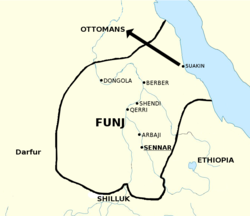
Back የፉንግ ግዛት Amharic سلطنة سنار Arabic Sultanatu de Sennar AST سنار سولطانلیغی AZB Сеннар солтанлығы Bashkir Фундж Byelorussian Soldanat de Sennar Catalan Sennarský sultanát Czech Sultanatet Sennar Danish Sultanat von Sannar German
Funj Sultanate السلطنة الزرقاء (in Arabic) As-Saltana az-Zarqa | |||||||||
|---|---|---|---|---|---|---|---|---|---|
| 1504–1821 | |||||||||
Funj branding mark (al-wasm)
| |||||||||
 The Funj Sultanate at its peak in around 1700 | |||||||||
| Status | Confederation of sultanates and dependent tribal emirates under Sennar's suzerainty [1] | ||||||||
| Capital | Sennar | ||||||||
| Common languages | Arabic (official language, lingua franca and language of Islam, increasingly spoken language)[2] Nubian languages (native tongue, increasingly replaced by Arabic)[3] | ||||||||
| Religion | Sunni Islam,[4] Coptic Christianity | ||||||||
| Government | Islamic Monarchy | ||||||||
| Sultan | |||||||||
• 1504–1533/4 | Amara Dunqas (first) | ||||||||
• 1805–1821 | Badi VII (last) | ||||||||
| Legislature | Great Council Shura[5] | ||||||||
| Historical era | Early modern period | ||||||||
• Established | 1504 | ||||||||
| 14 June 1821 | |||||||||
• Annexed to Egypt Province, Ottoman Empire[a] | 13 February 1841 | ||||||||
| Currency | barter[c] | ||||||||
| |||||||||
| Today part of | Sudan Eritrea Ethiopia | ||||||||
^ a. Muhammad Ali of Egypt was granted the non-hereditary governorship of Sudan by an 1841 Ottoman firman.[6]
^ b. Estimate for entire area covered by modern Sudan.[7] ^ c. The Funj mostly did not mint coins and the markets rarely used coinage as a form of exchange.[8] Coinage didn't become widespread in cities until the 18th century. French surgeon J. C. Poncet, who visited Sennar in 1699, mentions the use of foreign coins such as Spanish reals.[9] | |||||||||
The Funj Sultanate, also known as Funjistan, Sultanate of Sennar (after its capital Sennar) or Blue Sultanate (due to the traditional Sudanese convention of referring to black people as blue)[10] (Arabic: السلطنة الزرقاء, romanized: al-Sulṭanah al-Zarqāʼ),[11] was a monarchy in what is now Sudan, northwestern Eritrea and western Ethiopia. Founded in 1504 by the Funj people, it quickly converted to Islam, although this conversion was only nominal. Until a more orthodox form of Islam took hold in the 18th century, the state remained an "African empire with a Muslim façade".[12] It reached its peak in the late 17th century, but declined and eventually fell apart in the 18th and 19th centuries. In 1821, the last sultan, greatly reduced in power, surrendered to the Ottoman Egyptian invasion without a fight.[13]
- ^ Ofcansky, Thomas (June 1991). Helen Chapin Metz (ed.). Sudan: A Country Study. Federal Research Division. The Funj. Archived from the original on 9 January 2009.
- ^ McHugh 1994, p. 9, "The spread of Arabic flowed not only from the dispersion of Arabs but from the unification of the Nile by a government, the Funj sultanate, that utilized Arabic as an official means of communication, and from the use of Arabic as a trade language."
- ^ James 2008, pp. 68–69.
- ^ Trimingham, J. Spencer (1996). "Islam in Sub-Saharan Africa, till the 19th century". The Last Great Muslim Empires. History of the Muslim World, 3. Abbreviated and adapted by F. R. C. Bagley (2nd ed.). Princeton, NJ: Markus Wiener Publishers. p. 167. ISBN 978-1-55876-112-4.
The date when the Funj rulers adopted Islam is not known, but must have been fairly soon after the foundation of Sennār, because they then entered into relations with Muslim groups over a wide area.
- ^ Welch, Galbraith (1949). North African Prelude: The First Seven Thousand Years (snippet view). New York: W. Morrow. p. 463. OCLC 413248. Retrieved 12 August 2010.
The government was semirepublican; when a sultan died the great council picked a successor from among the royal children. Then—presumably to keep the peace—they killed all the rest.
- ^ "Text Viewer" فرمان سلطاني إلى محمد علي بتقليده حكم السودان بغير حق التوارث [Sultanic Firman to Muhammad Ali Appointing Him Ruler of the Sudan Without Hereditary Rights] (in Arabic). Bibliotheca Alexandrina: Memory of Modern Egypt Digital Archive. Retrieved 12 August 2010.
- ^ Avakov, Alexander V. (2010). Two Thousand Years of Economic Statistics: World Population, GDP, and PPP. New York: Algora Publishing. p. 18. ISBN 978-0-87586-750-2.
- ^ Anderson, Julie R. (2008). "A Mamluk Coin from Kulubnarti, Sudan" (PDF). British Museum Studies in Ancient Egypt and Sudan (10): 68. Retrieved 12 August 2010.
Much further to the south, the Funj Sultanate based in Sennar (1504/5–1820), rarely minted coins and the markets did not normally use coinage as a form of exchange. Foreign coins themselves were commodities and frequently kept for jewellery. Units of items such as gold, grain, iron, cloth and salt had specific values and were used for trade, particularly on a local level.
- ^ Pinkerton, John (1814). "Poncet's Journey to Abyssinia". A General Collection of the Best and Most Interesting Voyages and Travels in All Parts of the World. Vol. 15. London: Longman, Hurst, Rees, and Orme. p. 71. OCLC 1397394.
- ^ Bender, M. Lionel (1983). "Color Term Encoding in a Special Lexical Domain: Sudanese Arabic Skin Colors". Anthropological Linguistics. 25 (1): 19–27. JSTOR 30027653. Retrieved 15 March 2021.
- ^ Ogot 1999, p. 91
- ^ Loimeier 2013, p. 141.
- ^ Cite error: The named reference
Mooreheadwas invoked but never defined (see the help page).
